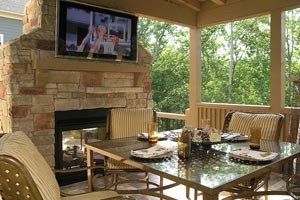
· Quick Tip :When the design for a landscape is developed, it is helpful to visualize the outdoors in the same manner as the indoors.
The home is a series of connecting living units. When the landscape designer sees the outdoor areas as rooms, the landscape becomes more familiar and easier to work with. Outdoor rooms have walls, ceilings, and floors, just as indoor rooms do The main difference between indoor and outdoor rooms is in the materials used to construct them. Outdoor walls may be developed using shrubs, fences, brick or stone, exterior walls of buildings, or trellises. Outdoor floors may be the natural earth, sand, crushed stone, poured concrete, brick, decking, turf grass, or many other similar surfacing materials. Out- door ceilings can be developed with trees, awnings, canopies, or other overhead structures.
Outdoor ceiling
· Trees are excellent materials for use in developing the outdoor ceiling (called a canopy). If an intimate patio setting is desired, a small tree branching overhead can create the low-ceiling effect (called a subcanopy). Also important to consider is the shade that the tree provides on a hot summer day. The southwest corner of a house will benefit greatly from the cooling effect of a medium to large tree planted nearby. Deciduous trees will allow the sun to pass through and warm the house with solar energy during the cold winter months.
Outdoor Wall
· The main function of the outdoor wall is to define the shape and limits of the outdoor room. Plants or constructed materials used alone may accomplish this; however, the combination of natural and constructed materials often creates the most attractive effect of all. The material selected for outdoor walls is usually determined by how much privacy and security is needed in the landscape. When total privacy or security is desired, the outdoor wall should be at least 6 feet tall and solid. When less privacy is needed or security is not a factor, the outdoor wall can be lower and more open.
Outdoor Floor
There are several groups of materials from which to select for the outdoor floor. Ex: Hard- scape paving includes paving brick, concrete, flagstone, tile, decking, and brick, among other materials. Hardscape paving is expensive to install but inexpensive to maintain.
Ex: Soft scape paving includes crushed stone, wood chips, marble chips, washed river gravel, pine needles, and other loose materials. Softscape paving has a moderate cost for both installation and maintenance. It requires periodic replacement of worn areas.
Ex:· Turf grass is the most popular of all surfacings. Turf has a low installation cost but a high maintenance cost, because it must be cared for regularly. Ground covers are good for surfacing areas where no one will be walk- ing, such as on slopes and directly under trees.
· The type of material chosen for the outdoor floor is certainly affected by what the client can afford. However, there are other needs of the individual client to consider:
1- Does the material absorb noise and/or dust?
2-How well does it blend in with the rest of the landscape?
3- Does it produce a glare from the sun? Does it track easily?
4- Does it become slippery when wet?